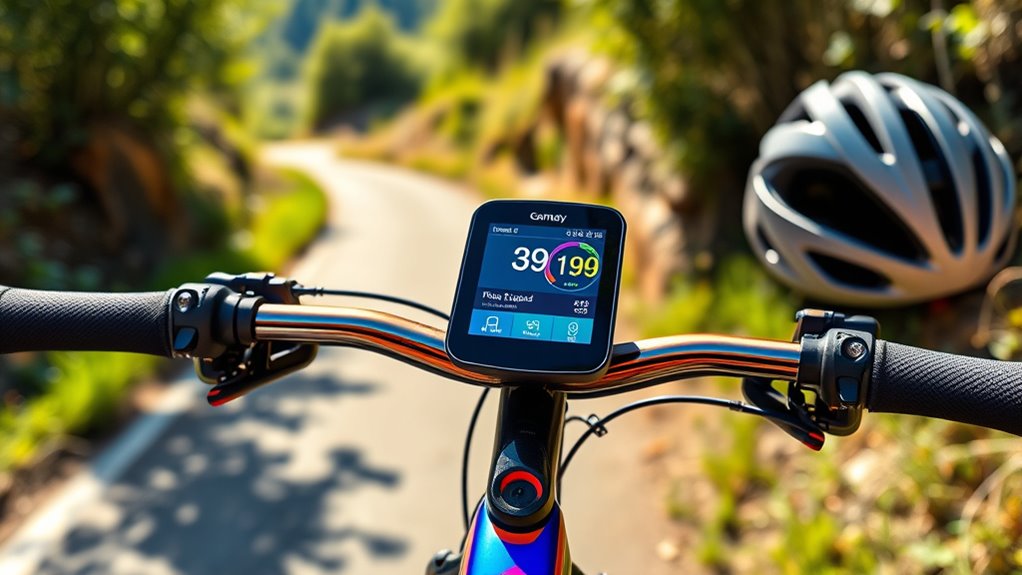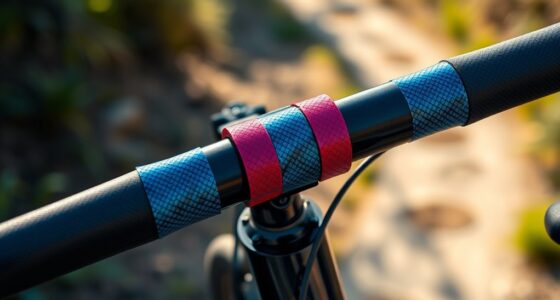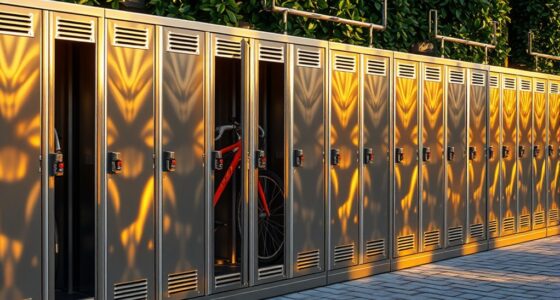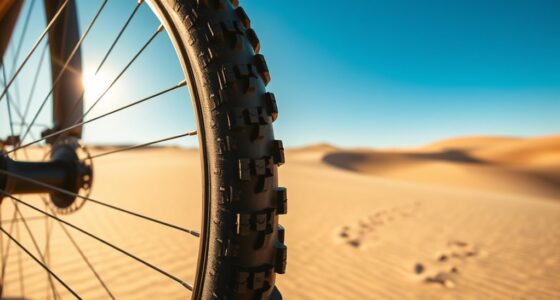If you’re looking to enhance your cycling experience in 2025, I’ve found 15 fantastic bike computers that’ll suit every rider. From the advanced Garmin Edge 530 GPS with performance monitoring to the budget-friendly CYCPLUS GPS, each option has unique features like navigation, wireless connectivity, and solid battery life. It’s all about finding what fits your needs best. Stick around, and I’ll share more details on each model to help you make the right choice.
Key Takeaways
- Look for bike computers with advanced GPS capabilities for accurate tracking and navigation during rides.
- Consider battery life; options with extended durations enhance long-distance ride reliability.
- Prioritize user-friendly interfaces and display quality for easy readability in various lighting conditions.
- Ensure compatibility with ANT+ and Bluetooth sensors for seamless connectivity with other devices.
- Evaluate price versus features to find a model that suits your cycling needs and budget.
Garmin Edge 530 GPS Cycling/Bike Computer
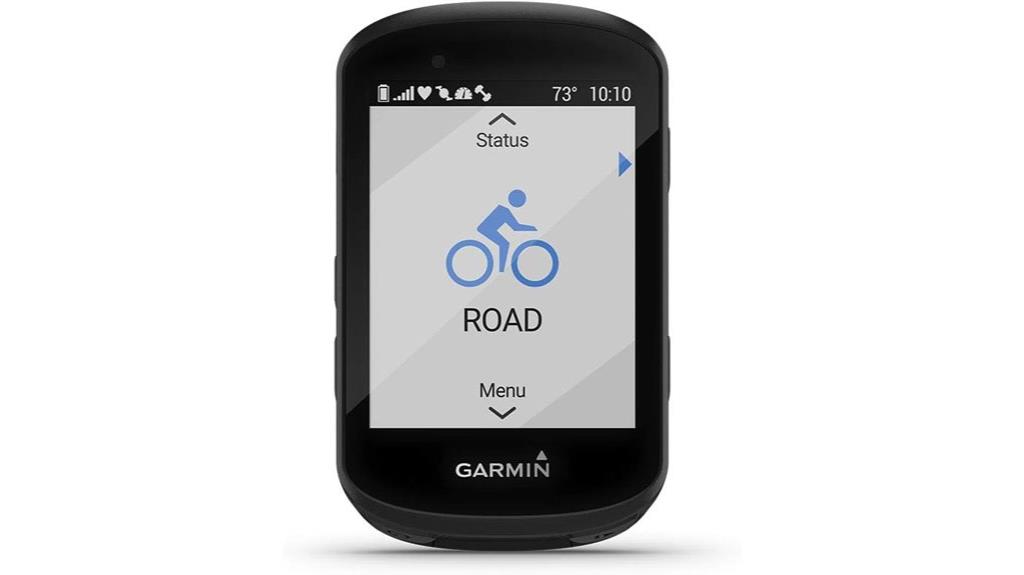
If you’re serious about your cycling performance, the Garmin Edge 530 GPS Cycling Computer is an excellent choice for tracking your rides. This device offers impressive mapping capabilities and dynamic performance monitoring, giving you insights into your VO2 max and recovery. I love how it integrates Trail forks data for mountain biking, too. The battery life is fantastic, lasting up to 20 hours, and you can extend it with a power pack. While it may seem a bit complex at first, the setup process is user-friendly, especially with the Garmin Connect app. It’s a solid investment for serious cyclists!
Best For: Serious cyclists looking for advanced performance tracking and mapping capabilities.
Pros:
- Dynamic performance monitoring provides insights into VO2 max, recovery, and more.
- Excellent battery life of up to 20 hours, extendable to 40 hours with a power pack.
- User-friendly setup process, especially with the Garmin Connect app for activity tracking.
Cons:
- The device may seem complicated for first-time users.
- Display visibility can be affected by mounting angle and lighting conditions.
- Lacks a touchscreen interface, which some users may prefer.
CC600 Wireless Color Screen Bike Computer
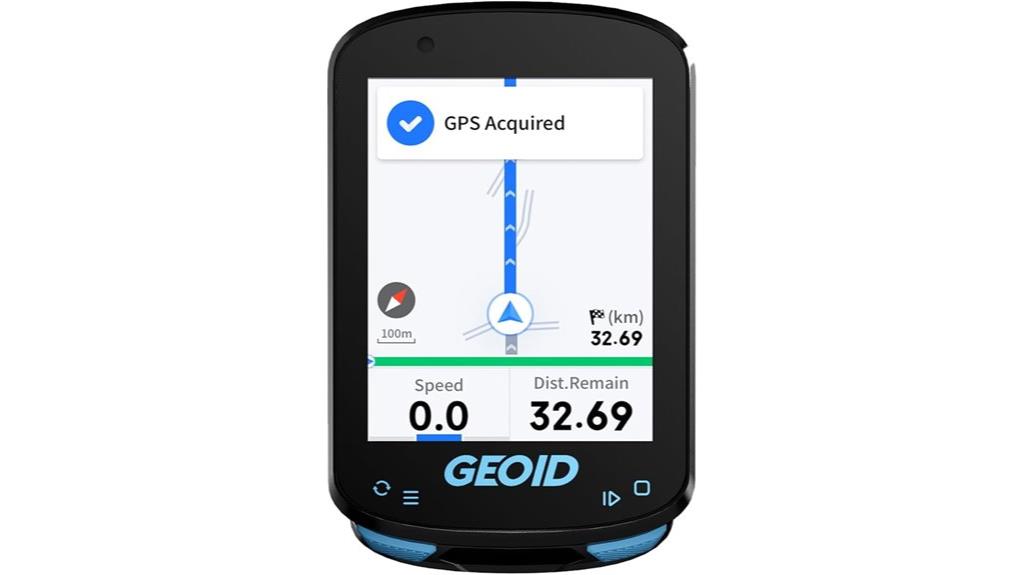
The CC600 Wireless Color Screen Bike Computer stands out with its vibrant 2.4″ display, making it perfect for cyclists who want clear visibility of their metrics while riding. Weighing just 2.61 ounces, its durable design features intuitive buttons for effortless navigation. With colorful route navigation and support for multiple satellite systems, you’ll never lose your way. The Bluetooth and ANT+ connectivity allows for seamless integration with various devices, enhancing your cycling experience. At around $70, it offers exceptional value, especially for those who want essential data without the frills. This bike computer is ideal for both casual and serious cyclists alike.
Best For: Cyclists seeking a reliable and easy-to-use bike computer that provides essential metrics without unnecessary features.
Pros:
- Bright and sharp 2.4″ color screen for easy visibility of data.
- Quick GPS connectivity with support for multiple satellite systems.
- Affordable price of approximately $70, offering great value for both casual and serious cyclists.
Cons:
- Some users report difficulties with the companion app.
- Bluetooth reconnection issues may arise after periods of inactivity.
- Limited advanced features compared to higher-end GPS bike computers.
Garmin Edge Explore 2 GPS Cycling Navigator

For recreational cyclists seeking a reliable companion on their rides, the Garmin Edge Explore 2 GPS Cycling Navigator stands out with its user-friendly interface and robust mapping features. The 3″ high-resolution touchscreen is glove-friendly and shines in sunlight, making navigation a breeze. I love the preloaded road and trail maps, plus the ability to create custom routes via the Garmin Connect app. Battery life lasts up to 15 hours, perfect for long rides. While it occasionally struggles in urban areas, overall, it’s a great tool for those focused on navigation and exploring new paths.
Best For: Recreational cyclists looking for an intuitive GPS navigator that enhances their cycling experience with reliable mapping features.
Pros:
- Easy-to-use 3″ high-resolution touchscreen that is responsive even with gloves and visible in sunlight.
- Long battery life of up to 15 hours, making it suitable for extended rides.
- Preloaded maps and customizable route planning options through the Garmin Connect app.
Cons:
- May experience lag in position updates and suggest impractical routes in dense urban environments.
- Lacks a true digital compass, which can limit precise directional guidance.
- Inability to export routes from Garmin Connect, hindering data manipulation for some users.
COOSPO Wireless GPS Bike Computer

Cyclists looking for an affordable and reliable tracking solution will find the COOSPO Wireless GPS Bike Computer to be an excellent choice. Its compact design features a 2.4-inch LCD display, ensuring visibility even in tough weather thanks to its waterproof construction. With dual GPS modes, it quickly captures signals for accurate tracking. I love how it pairs with ANT+ sensors and the CoospoRide app, simplifying setup and syncing with Strava. Users rave about its long battery life and ease of use. While some may notice minor accuracy issues, the overall performance and value make it a top pick for casual rides.
Best For: Cyclists seeking an affordable and reliable GPS tracking solution for casual riding.
Pros:
- Compact design with a clear 2.4-inch LCD display and waterproof construction for durability.
- Long battery life of approximately 28 hours and quick GPS signal acquisition for accurate tracking.
- Compatible with ANT+ sensors and the CoospoRide app for easy setup and syncing with Strava.
Cons:
- Some users report minor accuracy issues with speed and distance measurements.
- Bluetooth is only used for app pairing, limiting sensor connection options.
- May not meet the advanced tracking needs of competitive cyclists.
YS SY Wireless Bicycle Speedometer and Odometer
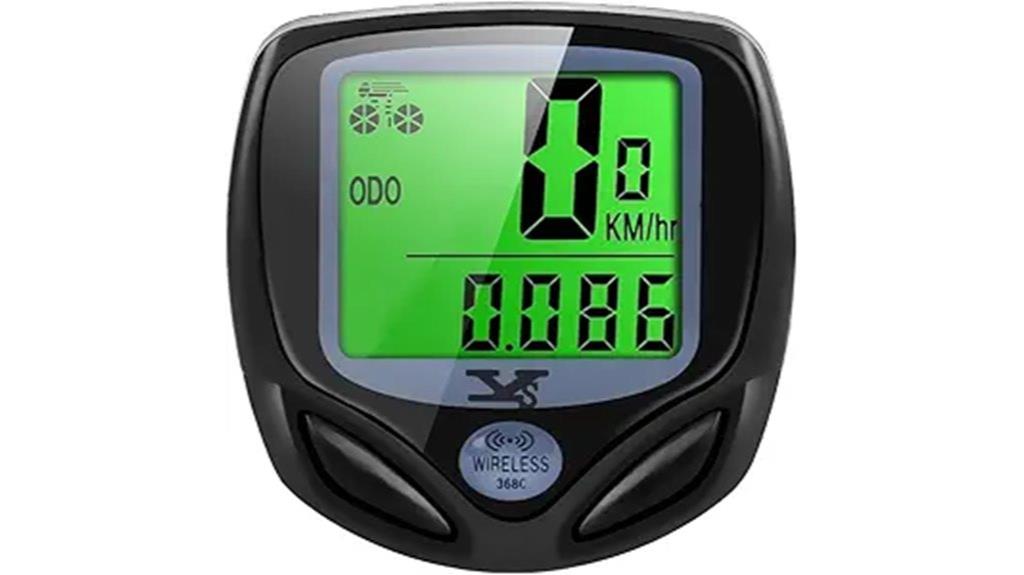
If you’re seeking a straightforward and reliable way to track your rides, the YS SY Wireless Bicycle Speedometer and Odometer stands out with its bright LCD display and multi-function capabilities. It features an auto wake-up function, ensuring it’s ready when I am. I love that it measures speed, distance, and riding time, and the customizable tire sizes guarantee accuracy. Installation is quick and easy, compatible with various bike types. While some users report occasional signal issues, I’ve found it simple to use and read. Overall, it’s a solid value for those wanting essential features without extra complexity.
Best For: Casual cyclists looking for an easy-to-use and efficient way to track their speed, distance, and riding time without added complexity.
Pros:
- Bright LCD display makes it easy to read ride statistics.
- Quick and simple installation process compatible with various bike types.
- Wireless design eliminates clutter from cables, enhancing convenience.
Cons:
- Some users experience erratic readings or signal interference.
- Battery life can vary significantly between users, with some reporting short durations.
- Instructions could be clearer, and a dedicated on/off switch for the backlight would be beneficial.
Wahoo ELEMNT Bolt V2 GPS Cycling/Bike Computer, Black

The Wahoo ELEMNT Bolt V2 GPS Cycling/Bike Computer shines with its on-device turn-by-turn navigation, making it an excellent choice for anyone who loves exploring new routes. I appreciate how it generates prompts directly from popular platforms like Strava and Komoot. The “Take Me To” feature lets me create routes on the fly, which is super convenient. With ANT+ radar integration, I feel safer as I get real-time alerts about approaching vehicles. Plus, its customizable screens enhance usability. With about 14 hours of battery life, it’s reliable for long rides, making it a solid investment for any cycling enthusiast.
Best For: Cycling enthusiasts who value navigation, safety, and performance tracking on their rides.
Pros:
- On-device turn-by-turn navigation with route generation from popular platforms like Strava and Komoot.
- ANT+ radar integration for real-time vehicle proximity alerts enhances rider safety.
- Customizable screens and a user-friendly interface improve usability during rides.
Cons:
- Some users have reported elevation inaccuracies and navigation limitations.
- Battery life, while estimated at 14 hours, may not be sufficient for ultra-long rides.
- Limited functionality without a paired smartphone for notifications and live tracking features.
CATEYE – Urban Wireless Bike Computer
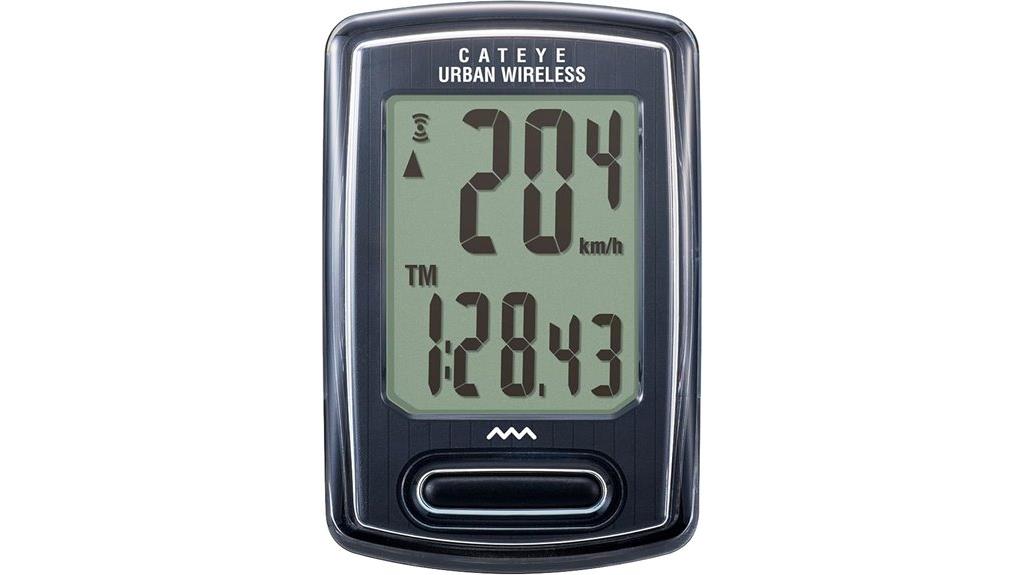
For anyone seeking a reliable and straightforward bike computer, the CATEYE Urban Wireless Bike Computer stands out with its user-friendly single-button interface. I love how it displays current, max, and average speed, along with total and trip distance. Tracking calories burned is a nice bonus too! The FlexTight Bracket makes mounting a breeze, though some may find installation tricky. I appreciate the well-illustrated instructions, but a little help from a bike shop can be beneficial. While it performs excellently in wet conditions, be cautious about potential interference with battery-powered lights. Overall, it’s a solid choice for any cyclist.
Best For: Casual cyclists looking for a reliable and user-friendly bike computer to track their performance and distance.
Pros:
- Easy-to-use single-button interface for cycling through displays.
- Tracks multiple metrics including speed, distance, and calories burned.
- Well-illustrated instructions aid in installation and setup.
Cons:
- Installation can be tricky, and some may require professional help.
- Potential interference issues with battery-powered lights.
- Durability concerns reported, such as strap breakage.
Orbit Velo Advanced Bike Tracker with Apple Find My
Looking for a reliable way to keep tabs on your bike while enjoying the freedom of cycling? The Orbit Velo Advanced Bike Tracker is a game-changer. Compatible with Apple’s Find My network, it lets you track your bike globally on any Apple device. I love its waterproof design and impressive three-year battery life. Plus, it comes with security bolts to deter thieves, making it discreet to install. Users rave about quick connectivity and successful recoveries of stolen bikes. Just keep in mind that tracking range can be limited if your phone’s not nearby. Overall, it’s a solid investment for any bike owner.
Best For: The Orbit Velo Advanced Bike Tracker is best for bike owners seeking a reliable and discreet way to track their bicycles and prevent theft.
Pros:
- Quick connectivity to Apple’s Find My network for effective tracking.
- Waterproof design with a long battery life of up to 3 years.
- Enhanced security features, including specialized bolts to deter theft.
Cons:
- Tracking range may be limited if the connected phone is not nearby.
- Some users report delays in signal notifications, sometimes up to 30 minutes.
- Mixed feedback on battery life, with some experiencing shorter durations than expected.
Bryton Rider S800 GPS Bike Computer Sensor Bundle

If you’re a serious cyclist seeking an extensive tracking solution, the Bryton Rider S800 GPS Bike Computer Sensor Bundle could be your ideal companion. With its vibrant 3.4-inch color touchscreen, I find it easy to read in any lighting. The bundle includes essential sensors and a heart rate monitor, enhancing my training analysis greatly. I love the pre-loaded maps and voice prompts, guiding me on every ride. Plus, with a battery life of up to 36 hours, I never worry about running out of juice. Despite some mixed reviews, the overall performance and value make it a solid choice for dedicated cyclists.
Best For: Serious cyclists seeking an extensive tracking solution with robust features and long battery life.
Pros:
- Includes essential sensors and a heart rate monitor for enhanced training analysis.
- 3.4-inch color touchscreen is easy to read in various lighting conditions.
- Pre-loaded maps and voice prompts provide excellent navigation support.
Cons:
- Mixed reviews on customer support and product reliability.
- Some users report issues with the Climb Challenge feature and app integration.
- Comparisons with competitors highlight potential shortcomings in certain areas.
Bike Speedometer Wireless Cycle Computer
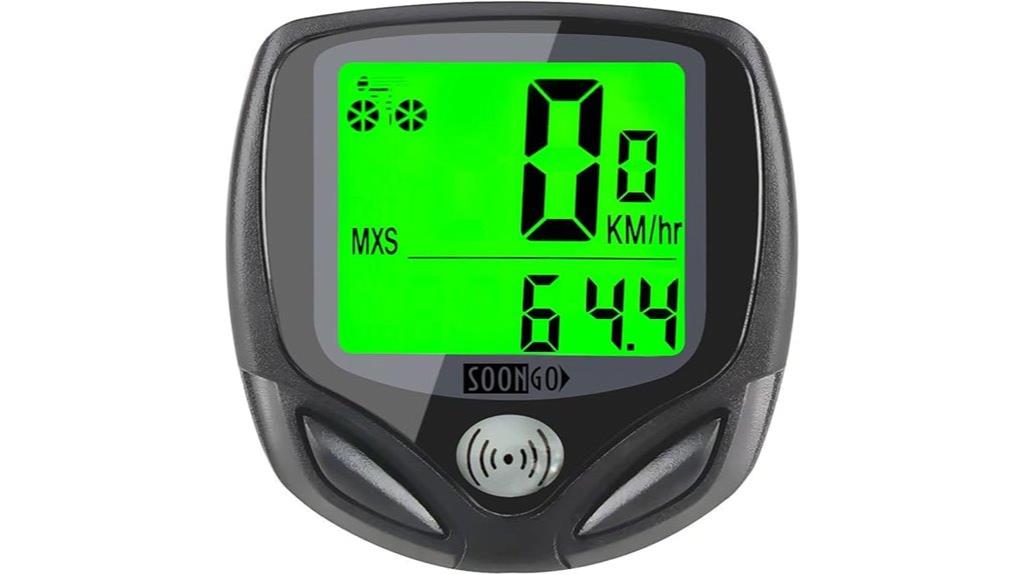
The SOON GO Bike Speedometer stands out as an excellent choice for cyclists who value accuracy and ease of use in tracking their rides. Its large LCD display with a green backlight guarantees visibility even at night, while the multi-function features record everything from average and maximum speeds to riding time and odometer. Installation is straightforward, though I found the zip ties for mounting could be sturdier. Battery life impresses me, lasting up to five years, and its waterproof design holds up in rainy conditions. While some users report occasional speed reading issues, overall, it’s a reliable companion for any ride.
Best For: Cyclists seeking an accurate and user-friendly wireless speedometer for tracking their rides.
Pros:
- Sturdy build and waterproof design suitable for various weather conditions.
- Large LCD display with a green backlight for excellent visibility at night.
- Impressive battery life lasting up to five years.
Cons:
- Mounting with zip ties may not be durable enough for all users.
- Some users report intermittent speed reading issues over time.
- Limited battery type (A27) may be inconvenient for replacements.
COROS DURA Solar GPS Bike Computer
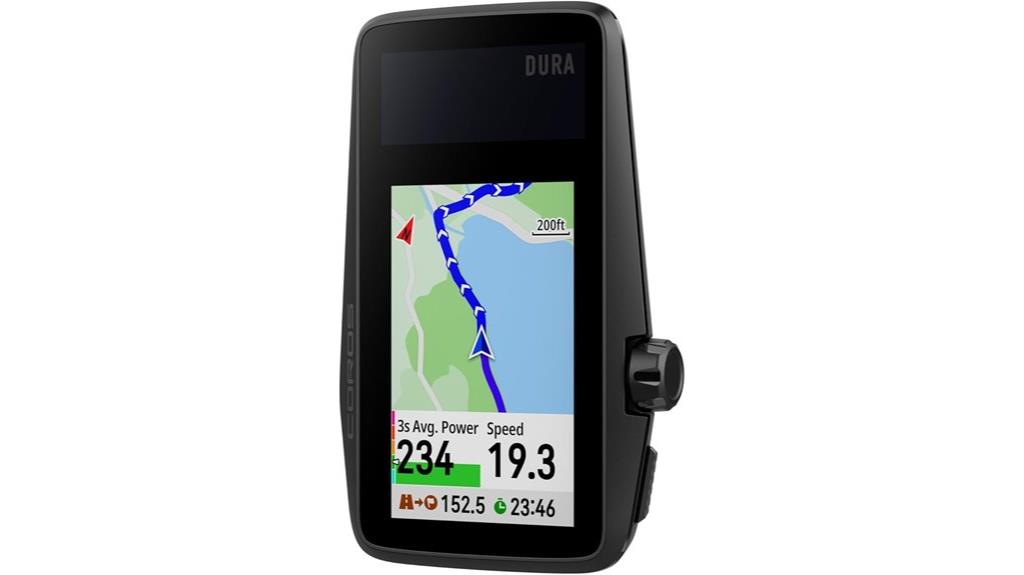
For cyclists who demand long-lasting battery life during extended rides, the COROS DURA Solar GPS Bike Computer stands out with its impressive 120-hour GPS operation on a single charge. I love how it harnesses solar power, gaining up to 2 extra hours of ride time per hour in direct sunlight. The 2.7 MIP color touchscreen is customizable and easy to read, even in bright sunlight. With turn-by-turn navigation and quick data syncing, I can share my rides on Strava almost instantly. While some features may vary, the DURA Solar proves its worth for serious cyclists seeking reliability and performance.
Best For: Serious cyclists who prioritize long battery life and reliable performance during extended rides.
Pros:
- 120-hour GPS battery life allows for extended use without frequent recharging.
- Solar charging capability provides up to 2 extra hours of ride time per hour in direct sunlight.
- User-friendly 2.7 MIP color touchscreen ensures clear visibility and easy navigation even in bright conditions.
Cons:
- Limited customization options in the app may frustrate users trying to manage data screen layouts.
- Inconsistent functionality with accessory pairing can lead to a lack of expected features.
- Mixed user feedback regarding software stability and customer support experiences may deter potential buyers.
COROS Bike Speed Sensor for Real-time Speed & Distance Tracking
Looking for a reliable way to track your speed and distance without relying on GPS? The COROS Bike Speed Sensor is a fantastic choice. It measures speed and distance accurately, integrating seamlessly with your bike computer, smartwatch, or smartphone via Bluetooth. Its compact design mounts easily to your wheel hub, and with an impressive battery life of up to 12 months, you won’t have to worry about constant replacements. The IP67 water rating guarantees it withstands any weather. Users rave about its performance, making it perfect for both outdoor rides and indoor training. Give it a try; you won’t be disappointed!
Best For: Cyclists looking for an accurate and reliable speed and distance tracking solution without GPS dependency.
Pros:
- Easy installation and setup process, both physically and through the app.
- Long-lasting CR2032 battery with up to 12 months of life.
- Compact and lightweight design with an IP67 water rating for all-weather durability.
Cons:
- Not compatible with most indoor spin bikes or ANT+ devices.
- May not provide the same level of detail as GPS-based sensors during specific scenarios.
- Limited to Bluetooth connectivity, which may not suit all users’ preferences.
CYCPLUS GPS Wireless Bike Computer
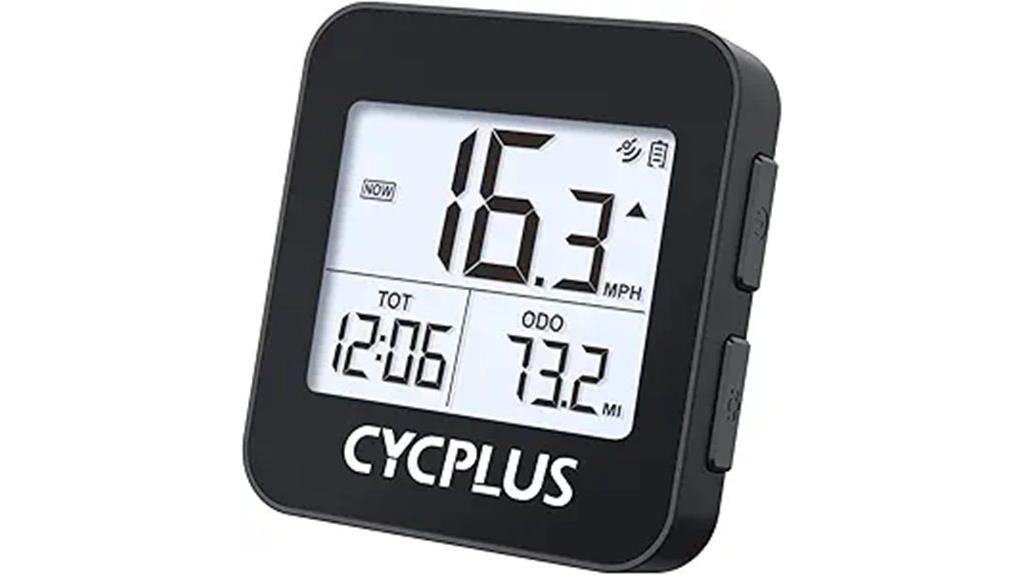
If you want a reliable bike computer that tracks your rides with impressive accuracy, the CYCPLUS GPS Wireless Bike Computer (G1) is an excellent choice. Weighing just 70 grams and featuring a 2-inch LCD display, it’s lightweight and easy to read. The dynamic GPS positioning guarantees precise tracking of ride time, distance, and altitude. I love the automatic backlight, which makes nighttime rides safer. With over 50 hours of battery life and an IPX6 waterproof rating, it withstands various weather conditions. While it’s slightly bulkier than wired units, its ease of use and portability make it a worthwhile investment for any cyclist.
Best For: Cyclists looking for a lightweight, easy-to-use bike computer that offers reliable GPS tracking and durability in various weather conditions.
Pros:
- Easy-to-read 2-inch LCD display with automatic backlight for nighttime visibility.
- Long battery life of over 50 hours and waterproof rating of IPX6 for use in diverse conditions.
- Wireless design eliminates cable clutter and allows for easy transfer between bikes.
Cons:
- Slightly bulkier compared to wired models, which may affect the aesthetics on the bike.
- Potential inaccuracies in distance tracking, particularly in wooded areas or tunnels.
- Instructions can be vague, requiring additional time to fully understand all settings and functions.
COOSPO Bike Cadence Speed Sensor BK9
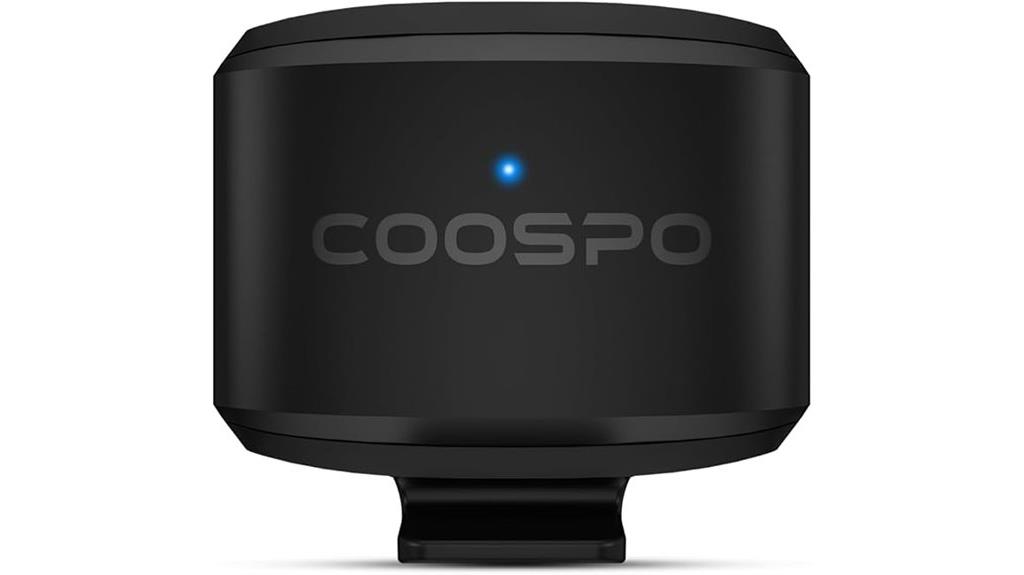
The COOSPO Bike Cadence Speed Sensor BK9 stands out as an ideal choice for cyclists who value seamless connectivity and accurate performance tracking. With Bluetooth 5.0 and ANT+ capabilities, it easily pairs with popular apps like Rouvy and Peloton. Its waterproof design and impressive 300-hour battery life make it reliable on any ride. I love how simple it is to install—no magnets required! However, I’ve noticed some lag in speed readouts at higher speeds. Overall, with a solid 4.4-star rating and a user-friendly experience, the BK9 enhances my cycling data collection effectively.
Best For: The COOSPO Bike Cadence Speed Sensor BK9 is best for cyclists seeking reliable performance tracking with easy app connectivity.
Pros:
- Dual connectivity with Bluetooth 5.0 and ANT+ for versatile compatibility.
- Waterproof design (IP67) and long battery life (300 hours) ensure durability.
- Easy installation with no magnets required, making it user-friendly.
Cons:
- Reports of lag in speed readouts at higher speeds.
- Limited information provided through ANT+ compared to Bluetooth.
- Inconsistent speed readings noted during use, which may affect accuracy.
COOSPO Wireless Bike Computer GPS
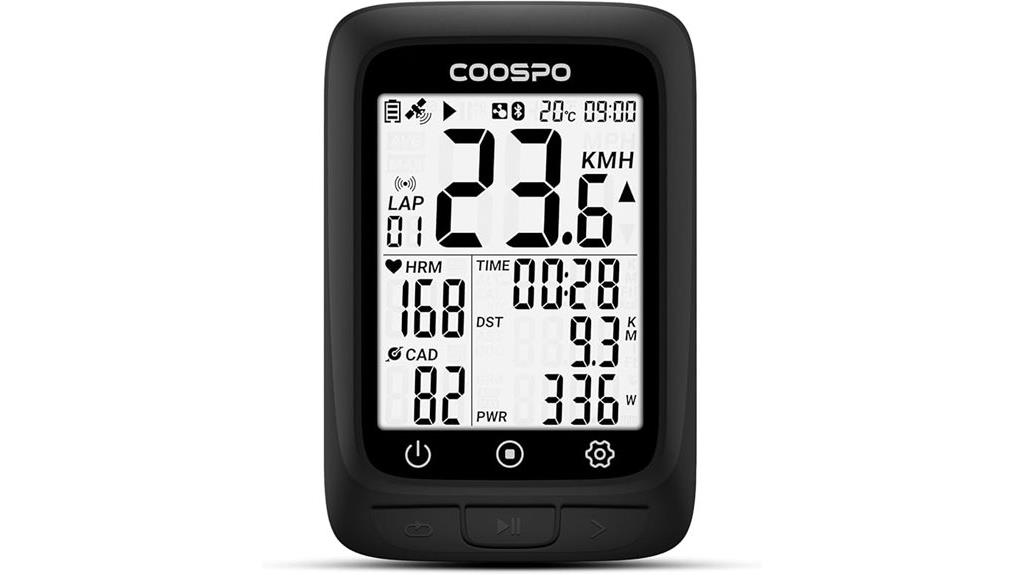
For budget-conscious cyclists seeking reliable tracking without the hefty price tag, the COOSPO Wireless Bike Computer GPS stands out as an excellent choice. Its 2.4-inch LCD screen is easy to read, even in sunlight, and the auto backlight is a great feature for evening rides. With accurate GPS positioning and support for various ANT+ sensors, it tracks my rides seamlessly. I love how it syncs with the CoospoRide App for detailed analysis. Plus, at just $40, it offers fantastic value compared to pricier options. Despite some initial setup challenges, it’s a solid investment for any cyclist.
Best For: Budget-conscious cyclists seeking reliable tracking features without the high price tag.
Pros:
- Accurate GPS positioning and easy-to-read 2.4-inch LCD screen with auto backlight for night riding.
- Supports various ANT+ sensors and seamlessly syncs with the CoospoRide App for detailed ride analysis.
- Affordable at $40, offering high value compared to more expensive bike computer options.
Cons:
- Initial setup can be challenging, particularly with Bluetooth connectivity issues on certain devices.
- Customer support may be inconsistent, leaving some users without helpful troubleshooting resources.
- Some users report difficulties with the CoospoRide App during the setup process.
Factors to Consider When Choosing Bike Computers for Tracking
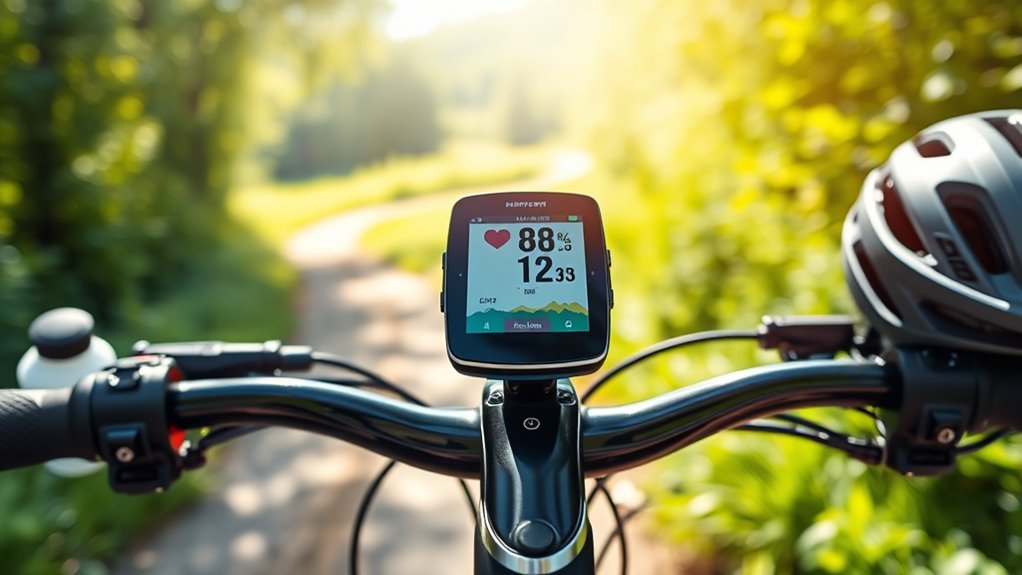
When I’m choosing a bike computer, I always consider how well it can navigate, the battery life, and the display quality. I also look at sensor compatibility and wireless connectivity options to guarantee it fits my needs. Each of these factors plays an essential role in enhancing my riding experience.
Navigation Capabilities
Choosing a bike computer with strong navigation capabilities can make all the difference in your riding experience. I always look for devices that offer turn-by-turn navigation, as this helps me stay on track and quickly reroute if I miss a turn. Supporting multiple satellite systems like GPS, GLONASS, and GALILEO is essential for accurate positioning, especially in tricky environments. I also appreciate bike computers with preloaded maps and the ability to upload custom GPX routes, giving me more flexibility during my rides. Smart rerouting features adjust my path based on real-time conditions, ensuring a smoother ride. Finally, I evaluate the user interface for touchscreen responsiveness and visibility in sunlight, making navigation easy and efficient.
Battery Life Duration
While I love exploring new trails, I can’t overlook the significance of battery life in a bike computer. I’ve found that battery life can really vary; some models boast up to 120 hours in full GPS mode, perfect for those long rides or bikepacking trips. For shorter outings, many wireless options offer 15 to 36 hours of battery life, giving me several days of use without needing a charge. I also appreciate devices that extend battery life through solar charging when I’m out in the sun. It’s vital to take into account how often I ride and for how long, as GPS tracking and display settings can impact overall battery performance. Longer battery life is essential for my adventures!
Display Quality
A bike computer’s display quality can make a world of difference during rides. I’ve found that larger screens, around 3 inches, with high resolution really enhance readability, especially in varying lighting conditions. Backlighting options are a game-changer for night rides or shaded paths, automatically turning on when needed. When considering display technology, I prefer touchscreens for their intuitive navigation, though I’ve noticed they can struggle in wet weather. Colorful displays also help me quickly differentiate between metrics at a glance, making tracking my performance easier. Finally, anti-glare features are essential for sunny days; they guarantee I can read my stats without squinting. All these factors contribute to an improved riding experience and help me stay focused on the road ahead.
Sensor Compatibility
When I look for a bike computer, sensor compatibility is a top priority. I make sure it supports ANT+ and Bluetooth protocols, which allows me to connect various sensors like heart rate monitors, speed sensors, and power meters. I also prefer bike computers that can link to multiple sensor types simultaneously, enhancing my data tracking and analysis for a more thorough cycling experience. It’s essential to check if the computer syncs with third-party apps for added functionality, such as route planning and performance tracking. Additionally, I verify compatibility with any existing sensors I own to avoid extra costs. Finally, I consider the battery life of the sensors, as longer-lasting batteries mean less maintenance and more riding time.
Wireless Connectivity Options
Choosing the right bike computer involves considering wireless connectivity options, as these can greatly enhance your riding experience. Most wireless models utilize Bluetooth and ANT+ protocols, allowing seamless connections with various sensors like heart rate monitors and power meters. This feature lets you pair up to nine devices simultaneously, boosting functionality during your rides. I love how Bluetooth connectivity enables easy setup, firmware updates, and real-time data syncing with smartphone apps. Some devices even auto-transfer ride data to popular cycling platforms, making sharing and analyzing performance metrics a breeze. Plus, wireless connectivity reduces cable clutter and enhances waterproof capabilities, giving you more flexibility in placing the computer on your bike.
User Interface Design
An intuitive user interface is essential for a seamless biking experience. I look for bike computers that have clearly labeled buttons and easy navigation, allowing quick access to functions without wasting time on setup. Display visibility matters too; high-contrast screens with adjustable backlighting make it easier to read in any light during my rides. Customizable data screens let me prioritize the metrics that matter most to me, enhancing my overall experience. While touchscreen interfaces can feel modern, I’ve found that traditional button layouts often perform better in wet conditions. Finally, clear user manuals and accessible online resources are invaluable for quickly learning how to use my bike computer effectively. These features make all the difference on the road.
Weather Resistance Rating
Weather resistance ratings play an important role in selecting the right bike computer for tracking my rides. I always check the IP ratings, as they indicate how well a device can handle dust and water exposure. For instance, an IPX6 rating means the computer can withstand powerful water jets, making it perfect for rainy days. Some devices even boast an IP67 rating, allowing them to be submerged in water up to 1 meter for 30 minutes. I also pay attention to the construction materials, since durable options enhance weather resistance. A waterproof design is vital for me, especially when I ride in unpredictable weather, as it prevents internal damage and guarantees the bike computer performs reliably.
Price and Value
When it comes to selecting a bike computer, understanding the price and value is essential. The price range can vary widely, with basic models starting around $30 and advanced ones exceeding $500. If you’re a casual cyclist, budget-friendly options priced between $40 and $70 provide essential tracking features without overwhelming complexity. However, if you’re serious about cycling, higher-end models offer advanced functionalities like GPS navigation and performance monitoring, justifying their costs. Remember to evaluate long-term value, including battery life and durability, as these factors can lead to savings and better performance over time. Checking customer reviews can also help you gauge reliability and perceived value, guiding you to make an informed decision on your next bike computer.
Frequently Asked Questions
How Do I Choose the Right Bike Computer for My Needs?
Choosing the right bike computer can feel overwhelming, but it doesn’t have to be. I always start by considering my riding style and goals. Do I need GPS tracking, heart rate monitoring, or just basic speed and distance? Then, I check battery life and ease of use, since I want something that won’t distract me while riding. Finally, I look at the price and reviews to guarantee I’m making a smart choice.
Are Bike Computers Waterproof or Water-Resistant?
I often wonder about bike computers and their durability. Most bike computers are designed to be water-resistant, which means they can handle some rain or splashes without damaging the electronics. However, not all of them are fully waterproof, so it’s important to check the manufacturer’s specifications. Personally, I prefer ones with higher water resistance ratings, especially for those unexpected downpours during my rides. It’ll give me peace of mind while cycling.
Can Bike Computers Be Used for Cycling Indoors?
You won’t believe how versatile bike computers are! Yes, you can absolutely use them for indoor cycling. I’ve found that they track my cadence, speed, and even heart rate while I’m pedaling away on my stationary bike. It’s like having a personal trainer right in my living room! Just make sure your bike computer’s compatible with your setup, and you’re all set to crush those indoor workouts. Enjoy the ride!
How Long Do Bike Computer Batteries Typically Last?
I’ve found that bike computer batteries typically last anywhere from several months to a couple of years, depending on usage. If I’m using GPS frequently, I notice the battery drains faster. Regular models usually need less power, while smart devices with advanced features might need more frequent charging. I always keep an eye on my battery life, ensuring I’m ready for my rides without any interruptions. It’s all about planning!
Are Bike Computers Compatible With Smartphone Apps?
I know some folks worry that bike computers can’t sync with smartphone apps, but that’s not true! Most modern bike computers are designed to be compatible with various smartphone apps. They often connect via Bluetooth or ANT+, letting you track your rides, analyze your performance, and even share your stats with friends. I love how this integration enhances my cycling experience, making it easier to stay motivated and engaged with my fitness goals.
Conclusion
To sum up, finding the right bike computer can truly enhance your riding experience. With so many options available, it’s crucial to choose one that fits your needs and helps you track your progress. As the saying goes, “The journey of a thousand miles begins with a single step.” So, whether you’re a casual rider or a serious competitor, investing in a quality bike computer will keep you motivated and on the right track for your cycling adventures ahead.
